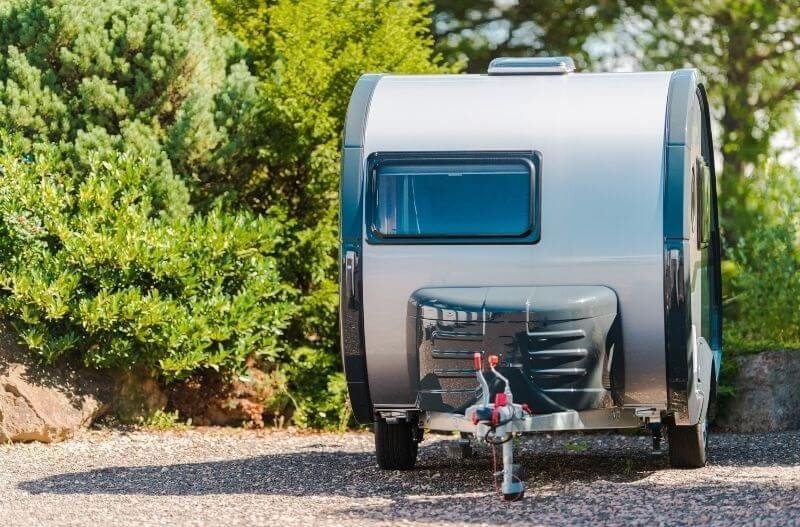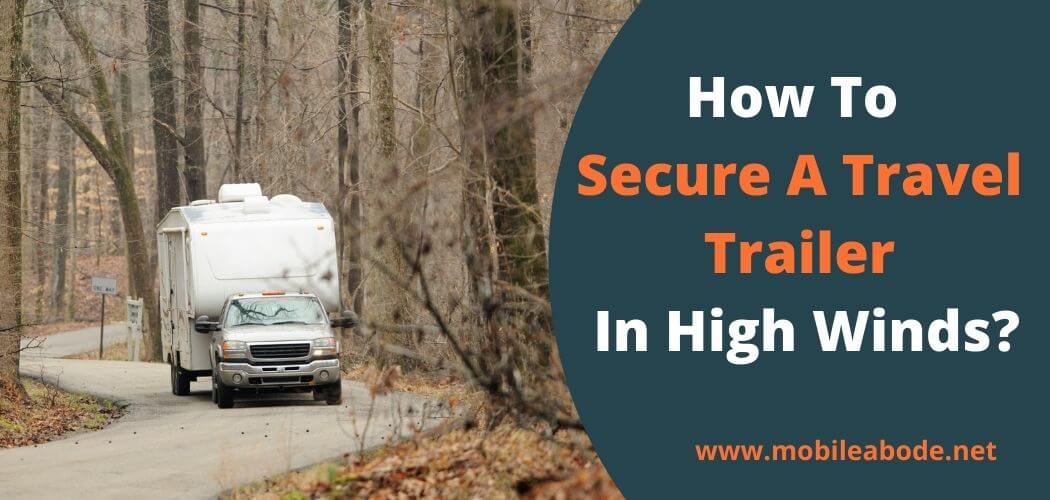Before we get into the specifics of how to secure your travel trailer in high winds, it’s important to understand some things about wind itself. Namely, the wind is fickle and unpredictable.
You could have a good setup with strong anchors in the ground only to find yourself having to take additional measures due to gusts coming from another direction.
To properly secure your travel trailer, you need to be prepared for anything Mother Nature can throw at you.
This article is divided into three sections: Anchoring in the Ground, Fixing in the Trailer, and Miscellaneous tips.
It’s important that you read through each section beforehand so you know what kind of preparations are necessarily based on your specific situation.
Methods to Secure A Travel Trailer In High Winds
1. Anchoring in the Ground
Travel trailers are big, heavy loads that are not easily moved by wind or any other outside forces.
The goal when anchoring them down is to keep them immobilized so they don’t blow away, but with enough leeway so that they are not ripped out of the ground by gale-force winds.
A word of caution before we continue, if your travel trailer is connected to a vehicle via a tow hitch, do not use this method for anchoring in the ground unless you have no other choice (i.e. there’s not many trees or other suitable options nearby).
It’s very likely that your vehicle and/or the tongue on your trailer will be wrenched from its position and could cause damage to both vehicles and/or people nearby.
Related Article: How Much Wind Will Destroy A Mobile Home?
2. Fixing in the Trailer
Even though it might seem like common sense when securing your travel trailer, always make sure all windows and doors are closed while you’re preparing to be hit by high winds.
There is nothing more dangerous than flying debris slamming into an open window.
The general method for securing your trailer in the event of high winds consists of four components: tying down anything that’s loose, putting away anything that could turn into a projectile, reinforcing doors and windows, and adding additional anchors if necessary.
Putting Away Items
This includes things like ladders, chairs, patio tables, etc… Anything that can be turned into a projectile should be put away before the storm hits.
If it’s not possible to put them away inside then tie them securely down or place some other kind of barrier in front of them.
Reinforcing Doors and Windows
After you have tied down loose items and moved potentially dangerous objects outside there are two options for reinforcing your doors and windows: use an actual device meant for this purpose or cover them with plywood.
Using something specifically designed to do so will ensure you have sufficient protection if the worst happens while covering your windows with plywood is less pretty, but it will get the job done just as well – plus you can use the plywood for more than just this purpose.
3. Anchoring Your Trailer
If you have a good place to permanently mount your travel trailer so it’s affected by winds from any direction, then you won’t need to worry about securing it in the first place since it will already be immobilized.
However, chances are good that you’re more mobile and might have to temporarily tie down your trailer if there is nowhere else to put it.

And if gale-force winds set in place immediately unhitch/detach your vehicle from the trailer! If not tied down properly a travel trailer could wrench itself loose while being towed and cause serious damage to both your vehicle and/or other people in the area.
If you find that your travel trailer is shifting in strong winds then it’s not adequately secure, so move on to one of the three anchoring techniques below.
Without using these methods properly, there is a chance that your travel trailer could tip over or even be ripped out of the ground!
Different Kinds of Anchors for Securing Trailers/RV’s in High Winds
There are three different kinds of anchors available for use with trailers: sandbags, tires, and gravel.
They all work equally well by keeping your trailer rooted to its spot but they do have their own pros and cons based on how accessible they are to you specifically.
1) Sandbags:- Sandbags are heavy bags filled with sand that you can buy for relatively low prices at local hardware stores.
The cons of this method are that it’s pretty much only good for flattening the ground under your trailer, not for breaking up chunks, and they don’t come in many different sizes so they might be too large or too small.
2) Tires:- After removing the valve stem to prevent damage during extremely high winds (more on that later), take off one of your vehicle’s tires and use an appropriately sized wrench to attach it to the trailer hitch.
Note: The wrench should fit around one of the bolts that attach it to the car/truck/SUV; don’t use a crescent wrench unless you’re trying to destroy something.
The pros of this method are that it’s cheap and doesn’t take up much space since you don’t need to buy a lot of them, but the cons include the fact that they’re not as heavy as sandbags and might not stay put if there is anything at all pushing against them.
3) Gravel/Crushed Stone:- This can be bought in large bags from local hardware or garden stores for only a few dollars per bag.
The downside to using gravel is that it’s hard to gauge its weight ahead of time, so if wind speeds pick up then you could end up with some serious damage to your hands.
Also Read: How To Evict A Mobile Home From My Land?
Conclusion:-
When it comes to securing a travel trailer in high winds, you have two options.
You can either secure the trailers from the ground with chains and straps or use an anchoring system that attaches directly to your vehicle’s hitch receiver.
If you choose not to anchor your trailer down, make sure that there is enough clearance so that when the wind blows forcefully against it, your trailer won’t tip over onto its side.
The best thing about using an anchoring system is being able to maneuvers around while still remaining securely attached at all times!
Of course, securing a travel trailer in high winds requires some attention to detail.
First and foremost, it is important that the wheels are properly blocked so they cannot turn freely while driving on windy days.
Next, be sure to use tie-down straps or rope when possible because bungee cords often fail under extreme conditions.
Finally, if you have an electric brake controller installed with your tow package then make sure it’s turned off during storms as adding electricity can cause shorts and fires in such volatile weather conditions!

